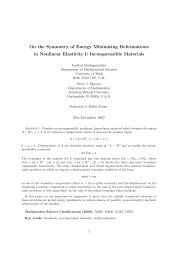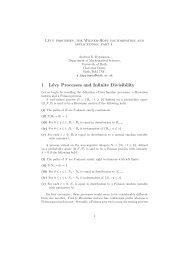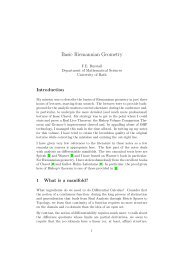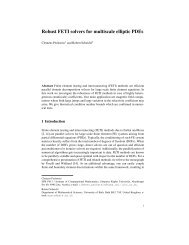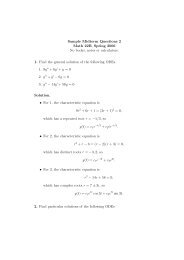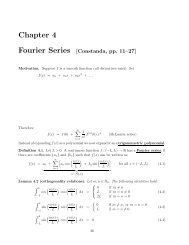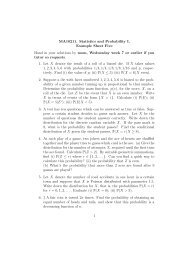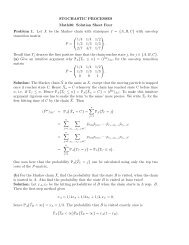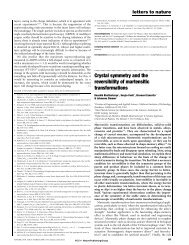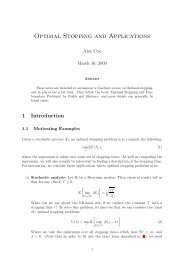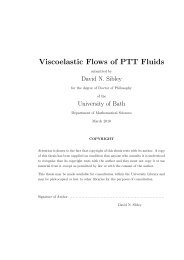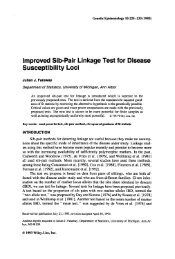Preface and Table of Contents
Preface and Table of Contents
Preface and Table of Contents
Create successful ePaper yourself
Turn your PDF publications into a flip-book with our unique Google optimized e-Paper software.
<strong>Preface</strong><br />
Linear models are central to the practice <strong>of</strong> statistics. They are part <strong>of</strong> the core knowledge<br />
expected <strong>of</strong> any applied statistician. Linear models are the foundation <strong>of</strong> a broad<br />
range <strong>of</strong> statistical methodologies; this book is a survey <strong>of</strong> techniques that grow from<br />
a linear model. Our starting point is the regression model with response y <strong>and</strong> predictors<br />
x 1 ,...x p . The model takes the form:<br />
y = β 0 + β 1 x 1 + ··· + β p x p + ε<br />
where ε is normally distributed. This book presents three extensions to this framework.<br />
The first generalizes the y part; the second, the ε part; <strong>and</strong> the third, the x part<br />
<strong>of</strong> the linear model.<br />
Generalized Linear Models: The st<strong>and</strong>ard linear model cannot h<strong>and</strong>le nonnormal<br />
responses, y, such as counts or proportions. This motivates the development <strong>of</strong><br />
generalized linear models that can represent categorical, binary <strong>and</strong> other response<br />
types.<br />
Mixed Effect Models: Some data has a grouped, nested or hierarchical structure.<br />
Repeated measures, longitudinal <strong>and</strong> multilevel data consist <strong>of</strong> several observations<br />
taken on the same individual or group. This induces a correlation structure in the<br />
error, ε. Mixed effect models allow the modeling <strong>of</strong> such data.<br />
Nonparametric Regression Models: In the linear model, the predictors, x, are<br />
combined in a linear way to model the effect on the response. Sometimes this linearity<br />
is insufficient to capture the structure <strong>of</strong> the data <strong>and</strong> more flexibility is required.<br />
Methods such as additive models, trees <strong>and</strong> neural networks allow a more flexible<br />
regression modeling <strong>of</strong> the response that combine the predictors in a nonparametric<br />
manner.<br />
This book aims to provide the reader with a well-stocked toolbox <strong>of</strong> statistical<br />
methodologies. A practicing statistician needs to be aware <strong>of</strong> <strong>and</strong> familiar with the<br />
basic use <strong>of</strong> a broad range <strong>of</strong> ideas <strong>and</strong> techniques. This book will be a success if the<br />
reader is able to recognize <strong>and</strong> get started on a wide range <strong>of</strong> problems. However,<br />
the breadth comes at the expense <strong>of</strong> some depth. Fortunately, there are book-length<br />
treatments <strong>of</strong> topics discussed in every chapter <strong>of</strong> this book, so the reader will know<br />
where to go next if needed.<br />
R is a free s<strong>of</strong>tware environment for statistical computing <strong>and</strong> graphics. It runs on<br />
a wide variety <strong>of</strong> platforms including the Windows, Linux <strong>and</strong> Macintosh operating<br />
systems. Although there are several excellent statistical packages, only R is both<br />
free <strong>and</strong> possesses the power to perform the analyses demonstrated in this book.<br />
While it is possible in principle to learn statistical methods from purely theoretical<br />
expositions, I believe most readers learn best from the demonstrated interplay <strong>of</strong><br />
v
vi<br />
PREFACE<br />
theory <strong>and</strong> practice. The data analysis <strong>of</strong> real examples is woven into this book <strong>and</strong><br />
all the R comm<strong>and</strong>s necessary to reproduce the analyses are provided.<br />
Prerequisites: Readers should possess some knowledge <strong>of</strong> linear models. The first<br />
chapter provides a review <strong>of</strong> these models. This book can be viewed as a sequel to<br />
Linear Models with R, Faraway (2004). Even so there are plenty <strong>of</strong> other good books<br />
on linear models such as Draper <strong>and</strong> Smith (1998) or Weisberg (2005), that would<br />
provide ample grounding. Some knowledge <strong>of</strong> likelihood theory is also very useful.<br />
An outline is provided in Appendix A, but this may be insufficient for those who<br />
have never seen it before. A general knowledge <strong>of</strong> statistical theory is also expected<br />
concerning such topics as hypothesis tests or confidence intervals. Even so, the emphasis<br />
in this text is on application, so readers without much statistical theory can<br />
still learn something here.<br />
This is not a book about learning R, but the reader will inevitably pick up the<br />
language by reading through the example data analyses. Readers completely new to<br />
R will benefit from studying an introductory book such as Dalgaard (2002) or one<br />
<strong>of</strong> the many tutorials available for free at the R website. Even so, the book should<br />
be intelligible to a reader without prior knowledge <strong>of</strong> R just by reading the text <strong>and</strong><br />
output. R skills can be further developed by modifying the examples in this book,<br />
trying the exercises <strong>and</strong> studying the help pages for each comm<strong>and</strong> as needed. There<br />
is a large amount <strong>of</strong> detailed help on the comm<strong>and</strong>s available within the s<strong>of</strong>tware <strong>and</strong><br />
there is no point in duplicating that here. Please refer to Appendix B for details on<br />
obtaining <strong>and</strong> installing R along with the necessary add-on packages <strong>and</strong> data necessary<br />
for running the examples in this text. S-plus derives from the same S language<br />
as R, so many <strong>of</strong> the comm<strong>and</strong>s in this book will work. However, there are some<br />
differences in the syntax <strong>and</strong> the availability <strong>of</strong> add-on packages, so not everything<br />
here will work in S-plus.<br />
The website for this book is at www.stat.lsa.umich.edu/˜faraway/ELM where<br />
data described in this book appears. Updates <strong>and</strong> errata will also appear there.<br />
Thanks to the builders <strong>of</strong> R without whom this book would not have been possible.
<strong>Contents</strong><br />
<strong>Preface</strong><br />
v<br />
1 Introduction 1<br />
2 Binomial Data 25<br />
2.1 Challenger Disaster Example 25<br />
2.2 Binomial Regression Model 26<br />
2.3 Inference 29<br />
2.4 Tolerance Distribution 31<br />
2.5 Interpreting Odds 31<br />
2.6 Prospective <strong>and</strong> Retrospective Sampling 34<br />
2.7 Choice <strong>of</strong> Link Function 36<br />
2.8 Estimation Problems 38<br />
2.9 Goodness <strong>of</strong> Fit 40<br />
2.10 Prediction <strong>and</strong> Effective Doses 41<br />
2.11 Overdispersion 43<br />
2.12 Matched Case-Control Studies 48<br />
3 Count Regression 55<br />
3.1 Poisson Regression 55<br />
3.2 Rate Models 61<br />
3.3 Negative Binomial 63<br />
4 Contingency <strong>Table</strong>s 69<br />
4.1 Two-by-Two <strong>Table</strong>s 69<br />
4.2 Larger Two-Way <strong>Table</strong>s 75<br />
4.3 Matched Pairs 79<br />
4.4 Three-Way Contingency <strong>Table</strong>s 81<br />
4.5 Ordinal Variables 88<br />
5 Multinomial Data 97<br />
5.1 Multinomial Logit Model 97<br />
5.2 Hierarchical or Nested Responses 103<br />
5.3 Ordinal Multinomial Responses 106<br />
vii
viii<br />
CONTENTS<br />
6 Generalized Linear Models 115<br />
6.1 GLM Definition 115<br />
6.2 Fitting a GLM 117<br />
6.3 Hypothesis Tests 120<br />
6.4 GLM Diagnostics 123<br />
7 Other GLMs 135<br />
7.1 Gamma GLM 135<br />
7.2 Inverse Gaussian GLM 142<br />
7.3 Joint Modeling <strong>of</strong> the Mean <strong>and</strong> Dispersion 144<br />
7.4 Quasi-Likelihood 147<br />
8 R<strong>and</strong>om Effects 153<br />
8.1 Estimation 154<br />
8.2 Inference 158<br />
8.3 Predicting R<strong>and</strong>om Effects 161<br />
8.4 Blocks as R<strong>and</strong>om Effects 163<br />
8.5 Split Plots 167<br />
8.6 Nested Effects 170<br />
8.7 Crossed Effects 172<br />
8.8 Multilevel Models 174<br />
9 Repeated Measures <strong>and</strong> Longitudinal Data 185<br />
9.1 Longitudinal Data 186<br />
9.2 Repeated Measures 191<br />
9.3 Multiple Response Multilevel Models 195<br />
10 Mixed Effect Models for Nonnormal Responses 201<br />
10.1 Generalized Linear Mixed Models 201<br />
10.2 Generalized Estimating Equations 204<br />
11 Nonparametric Regression 211<br />
11.1 Kernel Estimators 213<br />
11.2 Splines 217<br />
11.3 Local Polynomials 221<br />
11.4 Wavelets 222<br />
11.5 Other Methods 226<br />
11.6 Comparison <strong>of</strong> Methods 227<br />
11.7 Multivariate Predictors 228<br />
12 Additive Models 231<br />
12.1 Additive Models Using the gam Package 233<br />
12.2 Additive Models Using mgcv 235<br />
12.3 Generalized Additive Models 240<br />
12.4 Alternating Conditional Expectations 241
CONTENTS<br />
12.5 Additivity <strong>and</strong> Variance Stabilization 244<br />
12.6 Generalized Additive Mixed Models 246<br />
12.7 Multivariate Adaptive Regression Splines 247<br />
13 Trees 253<br />
13.1 Regression Trees 253<br />
13.2 Tree Pruning 257<br />
13.3 Classification Trees 261<br />
14 Neural Networks 269<br />
14.1 Statistical Models as NNs 270<br />
14.2 Feed-Forward Neural Network with One Hidden Layer 270<br />
14.3 NN Application 272<br />
14.4 Conclusion 276<br />
A Likelihood Theory 279<br />
A.1 Maximum Likelihood 279<br />
A.2 Hypothesis Testing 282<br />
B R Information 287<br />
Bibliography 289<br />
Index 297<br />
ix



